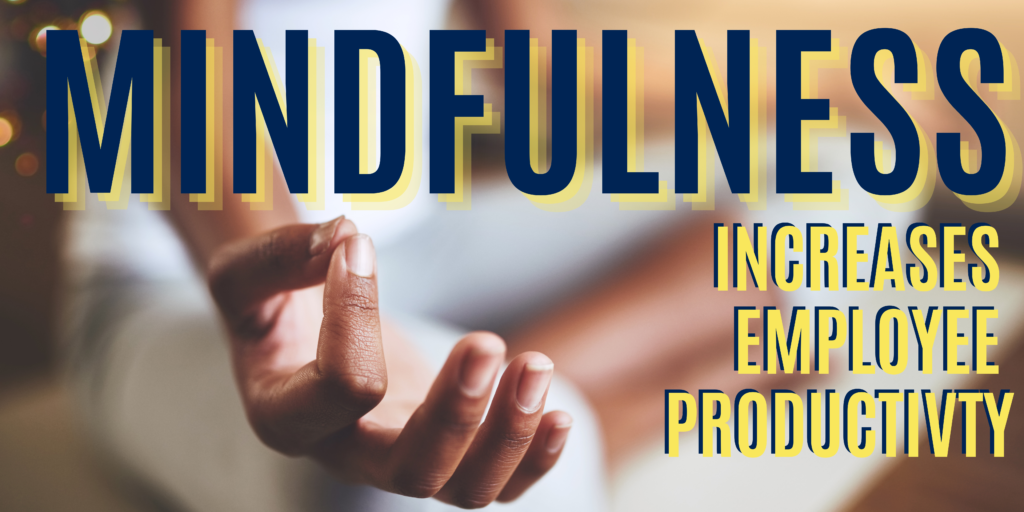Mindfulness in the workplace – I know. I know. Some of you are like, “Dude, stop with the meditation-wasting time stuff and get to work!”
But hear me out.
Mindfulness is more than a wellness trend. Did you know that, according to a study by Aetna, mindfulness programs can increase productivity by an average of 62 minutes per week per employee? That’s almost an extra workday each month!
But how many of you, as leaders, have thought about integrating mindfulness into your team dynamics without it feeling too ‘fu fu’ or ‘ra ra’?
I know the word ‘mindfulness’ can make some roll their eyes. But it’s not about sitting cross-legged and humming. How about instead of saying “mindfulness,” I say clarity and focus?
Because that’s the outcome of being more mindful.
Imagine your team being less stressed, more focused, and genuinely happier.
Today, I will share three practical, no-nonsense ways to embed clarity and focus into your team, organization, or community that even the most skeptical team members can get on board with.
Embedding Clarity and Focus Into Your Community

Integrated Gratitude
At the end of every daily huddle, our team takes 30 seconds to write down three things they are grateful for. Gratitude improves individual performance, directly impacting team and organizational performance. That’s huge! Thirty seconds is all it takes.
We call this integrated Gratitude because we are integrating it into a habit that already exists, which increases the chances that it will happen. It’s called Habit Stacking.
Some groups will ask each person to share one of their gratitudes out loud, but it’s not necessary to get the benefits. Just writing it and thinking about it yourself is enough.
Still not convinced that gratitude is beneficial? Gratitude can also increase employee engagement, leading to deeper connections among employees and to the work they do each day.
Research shows that employees are 50% more successful when leaders show gratitude for their efforts if a leader uses their gratitude for something someone else on the team has done.
Change The Environment
The second tip is to change the environment. Open office spaces sounded so cool for a while.
No walls. No barriers. Just direct, accessible, and open communication. Sadly, the introverts’ hearts and souls broke a little each time a new “open office space” idea was introduced.
Open office space is the opposite of mindfulness. But closed bunkers are also not the answer. Instead, here are three simple ways to bring more mindfulness into your office environment.
- #1 – Add more plants – Greenery isn’t just aesthetically pleasing; it’s a powerhouse of calm. According to a 2010 UTS research, workplaces spruced up with plants showed the following advantages: 37% reduction in anxiety. 44% reduction in office hostility. Reduced chronic fatigue by nearly 40%. 58% reduction in reported depression.
- #2 – Have a quiet room – A quiet room is a sanctuary for those who need to step back, breathe, and refocus. 58% of high-performance employees surveyed said they want more private office spaces for problem-solving and that quiet rooms increase productivity. A quiet room can be a haven for deep work, free from the constant buzz of an open office. It’s particularly beneficial for introverts who might find open office spaces overwhelming.
- #3 – Declutter – Clutter isn’t just a physical nuisance; it can be a mental burden, too. A study by the Princeton Neuroscience Institute found that visual clutter competes for attention, leading to decreased performance and increased stress. A clean workspace, free from distractions, improves concentration and efficiency. A clean, organized space can significantly enhance focus and efficiency. Encourage regular clean-up days and minimalistic desk policies.
These three elements can create a more balanced, mindful, and productive work environment. It’s about finding that sweet spot where open communication and personal space coexist harmoniously.
Walking Meeting
The third tip is about physical movement because, far too often, office life is a sedentary life. We are seated for the majority of our office day, which leads to chronic health problems such as heart disease, diabetes, and some cancers. It can also be detrimental to mental health, leading to anxiety and depression.
So, for tip 3, I’m suggesting that you do walking meetings.
Yes, you heard that right. Instead of gathering in a conference room, take your meetings on the go. Walking meetings aren’t just a breath of fresh air, literally, but they offer a shift in perspective, both physically and mentally.
Why walking meetings, you ask? Stanford University research found that walking boosts creative inspiration by an average of 60%. When we walk, our brain activity increases, leading to more free-flowing ideas and better problem-solving. But it’s not just about creativity. Walking side by side can break down formalities, encourage more open conversations, and can be less intimidating than a boardroom setting. This is especially effective for one-on-one catch-ups or brainstorming sessions. And let’s not forget the health benefits. We all know sitting for long periods isn’t great for our health. Incorporating walking meetings into your schedule promotes physical activity, which benefits both body and mind.
Of course, walking meetings won’t replace all types of meetings, but they can be a fantastic addition to your team’s routine. For instance, when discussing broad ideas, setting goals, or having informal check-ins, why not do it while walking?
So next time, instead of ‘let’s meet in the conference room,’ try ‘let’s walk and talk.’ You might be surprised at how this simple change can bring a new wave of energy and mindfulness to your team’s interactions.”
Bringing mindfulness into your team can profoundly impact productivity, well-being, and team dynamics. Leaders can foster a work culture that promotes clarity, focus, and happiness by integrating practices such as gratitude, creating a mindful environment, and incorporating physical movement. Research has shown that mindfulness programs can significantly increase productivity and individual performance, ultimately impacting team and organizational success.
By embracing these practical and no-nonsense ways to embed mindfulness into the workplace, leaders can create a more balanced, mindful, and productive environment where open communication and personal space coexist harmoniously. This approach benefits employees and contributes to a more resilient and successful organization.
